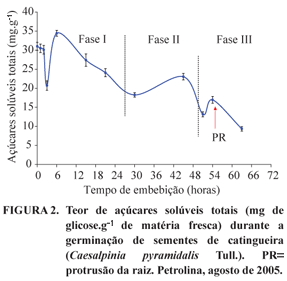Caesalpinia pyramidalis Tul. is a native species for caatinga biome, with a great resistance to drought and with great economic potential. The seeds germination comprehends cascade processes that start with the water imbibition and ends with the seedling emergence through the seed tegument. Once it starts, the activation of pre-existing hydrolytic enzymes and the denovo synthesis if other hydrolytic enzymes, leading to reserves mobilization. Little is known about the imbibition rate and germinative metabolism of C. pyramidalis, therefore the objective of this wok was to obtain the imbibition curve and evaluate biochemical changes that take place during germination of C. pyramidalis. Three replication of twenty seeds were subjected to each imbibition period, which were 1, 2, 3 hours (H) and after that at intervals of 3h until 72h. The seeds were placed in gerbox over two layers of germination paper moisten in 15mL of distilled water. Before and after each imbibition period the seeds were weighted and frozen until extraction and analysis of the contents of total soluble sugars (AST), reducing sugars (AR), starch and reserve proteinas (albumine, globuline, prolamine and gluteline). The imbibition curve fo C. pyramidalis seeds presented triphasic model, in wich phase (F) I was completed after 24h and FIII initiated after 51h imbibition, following root protrusion at 54h. The AR content increases during imbibition, while AST decreases and starch stays relatively constant during imbibition. Regarding the reserve proteins, albumine, globuline and prolamine increased during imbibition and, inversely, gluteline decreased during FI and remains constant during FII and FIII.
metabolism; germination; reserve mobilization; Caatinga






